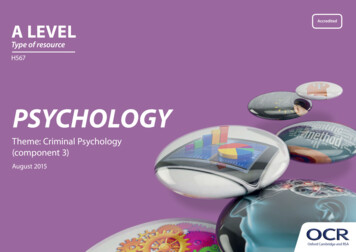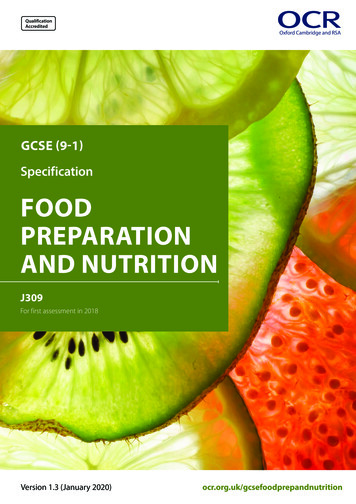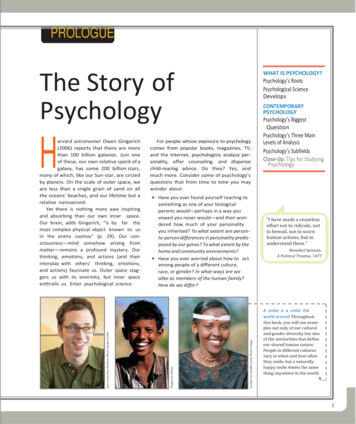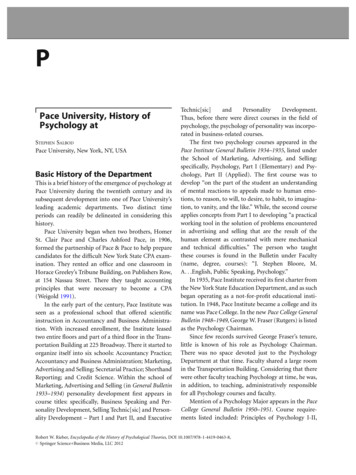
Transcription
A LEVELType of resourceH567PSYCHOLOGYTheme: Criminal Psychology(component 3)August 2015
We will inform centres about any changes to the specification. We will alsopublish changes on our website. The latest version of our specification willalways be the one on our website (www.ocr.org.uk) and this may differ fromprinted versions.Copyright 2015 OCR. All rights reserved.CopyrightOCR retains the copyright on all its publications, including the specifications.However, registered centres for OCR are permitted to copy material from thisspecification booklet for their own internal use.Oxford Cambridge and RSA Examinations is a Company Limited by Guarantee.Registered in England. Registered company number 3484466.Registered office: 1 Hills RoadCambridgeCB1 2EUOCR is an exempt charity.
A LEVELPSYCHOLOGYCONTENTSIntroduction Page 4Curriculum Content Page 5Thinking Conceptually Page 7Thinking Contextually Page 8Learner Resources Page 25Case Studies Page 33Key Research Summary Guides Page 363
IntroductionKEYDelivery guides are designed to represent a body ofknowledge about teaching a particular topic and contain: Content: a clear outline of the content covered by thedelivery guide;Thinking Conceptually: expert guidance on the keyconcepts involved, common difficulties learners may have,approaches to teaching that can help learners understandthese concepts and how this topic links conceptually toother areas of the subject;Thinking Contextually: a range of suggested teachingactivities using a variety of themes so that differentactivities can be selected that best suit particular classes,learning styles or teaching approaches.Click to view associated resourceswithin this document.Click to view external resourcesonlyIf you have any feedback on this Delivery Guide orsuggestions for other resources you would like OCR todevelop, please email resources.feedback@ocr.org.uk.4AS Level content only
Curriculum ContentAs part of Component 3 (Applied Psychology) of the A Level, there is a choice of two topics from a possible four. These arecriminal psychology, child psychology, sport and exercise psychology, and environmental psychology.The idea is to provide a range of alternative ways to deliver this content at A Level so teachers can pick and choose anapproach that suits them and their classes.There are six key topics that must be delivered for the chosen options, with background, research and application; thecontent for criminal psychology is below.Section B: Option 2 Criminal psychology (choose two out of the four options)TopicBackgroundKey researchApplicationWhat makes aPhysiological and noncriminal? (Biological) physiological explanations ofcriminal behaviour.Raine et al. (1997) BrainAt least one biological strategyabnormalities in murderersfor preventing criminalindicated by positron emission behaviour.tomography.The collectionand processing offorensic evidence(Biological)Hall and Player (2008) Will theintroduction of an emotionalcontext affect fingerprintanalysis and decision-making?Motivating factors and bias inthe collection and processingof forensic evidence.At least one strategy forreducing bias in the collectionand processing of forensicevidence.Collection ofCollection and use of evidence Memon, A. and Higham,evidence (Cognitive) from witnesses and suspects.P. A. (1999) A review ofthe cognitive interview.Psychology, Crime and Law. 5(1–2), 177–196.At least one strategy for policeinterviews.Psychology andthe courtroom(Cognitive)At least one strategy toinfluence jury decisionmaking.How juries can be persuadedby the characteristics ofwitnesses and defendants.Dixon et al. (2002) Accentsof Guilt: Effects of RegionalAccent, Race, and Crime Typeon Attributions of Guilt.5
Curriculum ContentTopicBackgroundKey researchApplicationCrime prevention(Social)How the features ofneighbourhoods and a zerotolerance policy can influencecrime.Wilson and Kelling (1982) Thepolice and neighborhoodsafety: Broken Windows.At least one strategy for crimeprevention.Effect ofimprisonment(Social)Punishment and reformas responses to criminalbehaviour.Haney et al. (1973) Study ofprisoners and guards in asimulated prison.At least one strategy forreducing reoffending.Specimen Assessment MaterialCriminal psychology7(a)* Explain how the research by Hall and Player (2008) could be used to improve fingerprint identification. [10]7(b)* Assess the usefulness of research into the collection and processing of forensic evidence. [15]A series of high profile serious violent crimes have been committed in a small village over the last year. Experts are workingon the case but it remains unsolved. There are a number of potential suspects including one who has a previous convictionfor assault.7(c)* Discuss how motivating factors might impact the collection and processing of forensic evidence in this case. [10]The questions above indicate the format of the assessment and mark allocations. Learners will be asked questions on the keyresearch and background, as well as applying their knowledge to a novel situation.6
Thinking ConceptuallyLessons for this module can be varied to include a range ofteaching, learning and assessment strategies. The range ofactivities described can be adapted to meet the needs ofthe individual learner and include a range of resources tostretch and challenge the most able learners and develophigher order thinking skills. The module lends itself well tothe integration of contemporary events in the news as pointsfor class discussion and development of learning. Thereforelearners should be encouraged to read the news and to sharetheir findings with the class. This will help to deepen theirlearning and foster A03 skills development.in. A barrier to learning may also be a lack of understanding ofthe judicial system (e.g. the role of the police and courts) andtherefore it is advisable that this is covered prior to embarkingupon the topics in this module.All topics within this module have a conceptual linkwith research methods. For example, the issue of samplegeneralisability is often questioned. Furthermore, due to thedifficulty with conducting research in forensic contexts, theissue of the ecological validity of the research is raised. There isalso a conceptual link with the biological, social and cognitiveapproaches. Therefore, in the delivery of the unit content it isadvisable that a recap of each of these approaches is made.The topics within it also overlap. For example the collectionof forensic evidence can be viewed from either a cognitive orbiological stance.Learners often have misconceptions about what criminalpsychology is. A useful starting point here is to direct them tothe British Psychological Society (www.bps.org.uk) where theycan research the careers that forensic psychologists engage7
Thinking ContextuallyThis topic can be taught using a range of resources and methods. All resources and ideas can be adapted to meet the needs ofthe learner, class size and the range of learning styles. Learners should be encouraged to undertake independent research fromcredible sources and this can be used to reinforce learning in the classroom. Some suggested video clips have been suggestedto facilitate understanding and some of these can be used as extension tasks. Wherever possible, the original research paperscan be used as a stretch and challenge activity under the careful guidance of the teacher. In order to develop A03 skills, casestudies have been provided. Learners could also research their own examples from credible sources and these could be used todevelop the application skills required to do well in this unit.8
Thinking ContextuallyTopic 1 – What makes a criminal? (Biological)BackgroundContentActivities / lesson ideasKey Issues to address ResourcesPhysiological andnon-physiologicalexplanations of criminalbehaviourDistinguish between biological (nature/physiologicalfactors) and environmental factors (situational explanations/upbringing/nurture) to explain criminality.Nature/nurtureTask – Learners work in pairs to list reasons why peopleturn to crime. All learners to feed back to whole group, andteacher to make notes on whiteboard (grouping themesinto nature/nurture where appropriate).Task – Discuss the work of Lombroso. In pairs, learnersresearch one classic case study outlining the role of braindysfunction in explaining behaviour. Learners then ‘peerteach’ and together form a conclusion about the role ofbrain dysfunction in explaining behaviour and then how thiscould be applied to criminal activity.The following articles can be used by learners as evidence ofphysiological or non-physiological explanations:Psychology as ascienceClick hereClick here1) http://www.bbc.co.uk/news/health-126495552) 7/the-brain-on-trial/308520/Click here3) http://www.bbc.co.uk/news/magazine-317148534) tml5) l9Click hereClick here
ThinkingThinkingContextuallyContextuallyContentKey Research Raine et al. (1997)Brain abnormalities inmurderers indicated byPET scansActivities / lesson ideasKey Issues to address ResourcesKey concepts: Brain dysfunction, brain localisation,brain scanning, brain regions, multi-site deficitsPsychology as ascienceStarter activities – What is a PET scan? Learners researchusing NHS website link:Conceptual link toresearch methods (e.g.experimental design,control /Introduction.aspxDeterminismTask – Differentiated learning activity. Teacher to allocatesections from the study according to ability. Learners work in Ethicssmall groups to read through relevant sections of the study.Each learner to then feed back and in groups create a studysummary in the form of a poster. The Learner Resource6 sheet could be used here or wherever learners evaluateresearch.A detailed presentation can be found on esources/./AS OCRRaineKillerBrains.pptExtension task – ‘The Anatomy of Violence by Adrian RaineReview’: my-violence-adrian-raine-review. This article offers acritique of the research and can be used as a stretch andchallenge resource. Teachers could ask learners to identifytwo criticisms of the research.Click hereLearnerResource6Click hereClick hereAn interview with Adrian Raine can be listened to. Questionscould be given to learners to answer while listening to gical10Click here
Thinking ContextuallyApplicationContentActivities / lesson ideasKey Issues to address ResourcesAt least one biologicalstrategy for preventingcriminal behaviourIdea – Learners to review the following newspaper article by EthicsRaine as homework activity, then to come to class with twoReductionismapplications from the article.Socially ow-to-spotresearcha-murderers-brainClick hereIdea – Silent debate. Learners work in pairs/small groups(this can be adapted to suit learner needs). Each group to begiven a piece of flipchart paper with the statement ‘Neuralscanning should be used to identify people at risk of violentbehaviour’. As part of the silent debate each learner has tomake a point (linked to a psychological theme/evidence) toeither support or refute the argument. The other learner(s)have to reply. Rules: no talking and at the end of the debatethere must be arguments for and against on the flipchartpaper.Idea – An alternative debate or research task could bedone on chemical castration. A ‘for and against’ table couldbe completed as part of this activity. These articles may beuseful for ns-and-probation-criminaljustice11Click hereClick here
Thinking ContextuallyTopic 2 – The collection and processing of forensic evidence (Biological)BackgroundContentActivities / lesson ideasKey Issues to address ResourcesMotivating factors andbias in the collectionand processing offorensic evidenceTask – Learners research the misidentification of BrandonMayfield as an example of how fingerprint evidence is notalways reliable. This could be done as a homework task priorto the lesson and used as part of a question and answerstarter activity.ReliabilityValidityPsychology as ascienceExtension task – Learners could research any other caseswhere there has been an error in the collection of forensicevidence.Task – Ideas blast: In small groups learners identify differentways evidence may be collected. Different groups can thenshare their ideas with the class.The following clip gives learners an introduction intoforensic evidence collection: https://www.youtube.com/watch?v wri9LXFBBnATask – As a follow up, learners can be allocated a typeof forensic evidence that is collected at crime scenes toresearch; this can be presented to the rest of the class. A walldisplay could be created with the heading ‘Crime Scene’.Task – Learners work in small groups to identify the featuresof a crime/crime scene that affect the emotional state ofthe expert and lead to errors in the interpretation of forensicevidence. Learners to list as many features as possible. Thesecould include, for example, the nature and seriousness ofthe crime, the characteristics of the victim, the personal biasof the expert, any physical or psychological harm to thevictim, the age of the victim and use of a weapon.12Click here
Thinking ContextuallyContentKey Research Hall and Player (2008)Will the introduction ofan emotional contextaffect fingerprint analysisand decision-making?Activities / lesson ideasKey Issues to address ResourcesKey concepts: Ridge identification, emotional context,confirmation bias, subjectivityPsychology as ascienceShow clips to provide an understanding of how fingerprintsare formed and how they are used as forensic evidence:Ecological validityWhat is a fingerprint?https://www.youtube.com/watch?v qX6hFXHDmk4Are fingerprints reliable as evidence in court?https://www.youtube.com/watch?v t3ppAEvI2kITask – Learning Resource 1 – Relay activity. Learners towork together in small groups to answer questions aboutthe study. Learner collects a question from the teacher and‘runs’ back to the group to research the answer. The nextlearner then brings their answer to the teacher and picks upthe next question (teacher checks that learning has takenplace from the written answers).Differentiation can be achieved through utilising a range ofresources e.g. the original research paper for the most ablelearners. At the end the teacher summarises the main pointsabout the study using Socratic dialogue and learners maketheir own study notes.13Conceptual link toresearch methods (e.g.null hypothesis testing)Click hereClick hereLearnerResource1
Thinking ContextuallyApplicationContentActivities / lesson ideasKey Issues to address ResourcesAt least one strategyfor reducing bias inthe collection andprocessing of evidenceIdea – Learners could write a set of policy guidelines fortheir local police service outlining strategies for reducingsubjectivity (e.g. reducing emotional stimuli, removingdetails of the crime that may not be needed for an accuratefingerprint match). This could be presented in the form of aposter.EthicsEcological validityIdea – Learners could prepare a presentation to the relevantprofessional body outlining strategies for reducing bias andsubjectivity when analysing fingerprint matches.Topic 3 – Collection of evidence (Cognitive)ContentBackgroundActivities / lesson ideasKey Issues to address ResourcesCollection and use ofIdea – As a starter activity learners are asked to list problems Psychology as aevidence from witnesses with interviewing witnesses.scienceIdea – What are the features of a good interview?Conceptual link tocognitive approachand research methods(e.g. lab experiment)Idea – Learner Resource 2 – ‘How memory works’. Learnersshould re-visit the Loftus and Palmer (1974) study. It isimportant that the conclusion from the study is emphasised,not just a description. Teachers can then lead a discussionEcological validityabout the practical applications/usefulness of this research.Podcast – Learners can makes notes or answer questionsset by the teacher relating to the podcast: e/14LearnerResource2Click here
Thinking ContextuallyContentKey Research Memon and Higham(1999) A review of thecognitive interviewActivities / lesson ideasKey Issues to address ResourcesKey concepts: Cognitive Interview (CI), EnhancedCognitive Interview (ECI), context reinstatement, visualimagery, mnemonics, cognitive overloadPsychology as ascienceTen minute video clip demonstrating the CI with a real caseand some of the problems witnesses face:https://www.youtube.com/watch?v jyMLDN9UOrEIdea – Cognitive interview practical. Learners watch the cliphttps://www.youtube.com/watch?v v QbTX2qS10 then inpairs one conducts the cognitive interview and the otheracts as the witness. Was it effective? https://www.youtube.com/watch?v VZhcp6dOKdsEcological validityReliabilityConceptual link toresearch methods (e.g.cause and effect) andthe cognitive approachAt least one strategy forpolice interviewsIdea – Case Study 1. Learners work in pairs as ‘policeofficers’ to plan a cognitive interview to aid recall. A rangeof ‘props’ could be used to encourage learners to get intorole as a police officer (e.g. tape recorder, clipboard, policeuniform/hat).Idea – Write a set of training guidelines to be sent to theTraining Manager of your local police service advising onguidelines to follow when conducting interviews withwitnesses.15Click hereClick hereIndividual differencesIdea – Learner Resource 3a/b – Diamond 9 activity.Based on reading and research (e.g. summary sheets, bookchapters, Youtube research and original research), learnerswork together to complete a ‘Diamond 9 activity’ to prioritisewhat makes an effective cognitive interview. This could bedone in mixed-ability groups. The rule is that learners haveto discuss their answers. As a differentiated activity, teacherscould give more able learners a blank grid and learners thenidentify their own terms before prioritising them on theDiamond 9.ApplicationClick tyCaseStudy 1
Thinking ContextuallyTopic 4 – Psychology and the courtroom (Cognitive)BackgroundContentActivities / lesson ideasKey Issues to address ResourcesHow juries canbe persuaded bythe characteristicsof witnesses anddefendantsIntroductory article to be discussed:Conceptual link tosocial htmlClick hereIdea – Thinking Skills Bingo. Learners to draw a 3 3 gridon a mini whiteboard. Working in pairs or small groups,learners to identify a range of factors about a witness or adefendant that can affect jury decision-making. Teacher willalso have generated a list of 12 factors and will then readthese descriptions out as the groups play ‘bingo’. Factors forthe bingo grid may include attractiveness, accent, gender,age, race, amount of jewellery, tattoos, clothing, height, howclearly spoken they are, facial hair/clean shaven, cleanlinessetc. This can be adapted to suit learner need (e.g. 12 termscould be written on the board and the learner choosesnine).Idea – Discuss ‘Halo Effect’. Learners to research Sigall andOstrove’s 5-00116Click here
Thinking ContextuallyContentKey Research Dixon et al. (2002)Accents of Guilt: Effectsof Regional Accent,Race, and Crime Type onAttributions of GuiltActivities / lesson ideasKey Issues to address ResourcesKey words – Matched guise, perceived superiority, social Ecological validityattractiveness, blue-collar/white-collarResearch designIdea – Learners could summarise the study in the form of aSampling methodsstoryboard/visual presentation (e.g. Powtoon).Idea – Learners could apply their knowledge of researchmethods and conduct a study of their own. For example,they could devise vignettes of characters with differentaccents/race/gender/type of crime and ask participants(learners/teachers at their school/college) to judge the‘guiltiness’ of the suspects. They could then analyse theirfindings and present them in the form of a poster orelectronic presentation.Idea – Learners could practise their knowledge of researchmethods by identifying the IVs and DV in the study and thenformulating an alternative and a null hypothesis.17
Thinking ContextuallyApplicationContentActivities / lesson ideasKey Issues to address ResourcesAt least one strategy toinfluence jury decisionmakingIdea – Learners could devise a presentation for potentialjurors explaining the social psychological research in thisarea and listing the factors to avoid. The article attached isalso an interesting extension -understandtheir-job.htmlIdea – Learners could write a set of guidelines to be givento jurors detailing factors that they should ignore in thecourtroom.As an extension task learners could research some of theproblems with studying juror behaviour and present theirfindings to the class. An adaptation of this could be to set upa forum on the school/college VLE with the question “Whyis it difficult to research jury decision-making?”. Each learnerthen replies to the others’ posts.18Click here
Thinking ContextuallyTopic 5 – Crime prevention (Social)ContentBackgroundActivities / lesson ideasKey Issues to address ResourcesHow the features ofIdea – Learners to research the crime rates/types and crimeneighbourhoods and aprevention strategies in their residential area (e.g. contactzero tolerance policy can their local PCSO, Neighbourhood Watch etc).influence crimeIdea – Learners to collect local newspaper articles aboutlocal crime and share with the class. These could be usedas a classroom display and at the end of the topic could bere-visited to focus on how the crime could be prevented.Alternatively they could be ‘pinned’ to an electronicpinboard (e.g. Pinterest).Idea – Research William Bratton’s (New York City PoliceCommissioner) ‘Zero-tolerance’ approach to petty crime.This should be done before introducing the key research.Learners could do this as a homework activity, and it couldinclude the following 1453617319Quantitative dataReliabilityClick here
Thinking ContextuallyContentKey Research Wilson and Kelling(1982) The police andneighborhood safety:Broken WindowsActivities / lesson ideasKey Issues to address ResourcesKey concepts: Broken windows theory,neighbourhoods, zero tolerance, policing, crimeprevention, community controlsValidityIdea – Learner Resource 4 – Learners to research brokenwindows theory and answer the research questions.In addition to the original research paper and the learners’own independent research, the following links are n-windowspolicing/https://www.youtube.com/watch?v hive/1982/03/broken-windows/304465/Links to extension activities that offer a critique of ts/broken.pdfhttps://www.youtube.com/watch?v oAsBbTwpqvEReliabilityPsychology as ascienceLearnerResource4Click hereClick hereClick hereClick herehttps://www.youtube.com/watch?v gG3AKoL0vEsClick hereClick here20
Thinking ContextuallyApplicationContentActivities / lesson ideasKey Issues to address ResourcesAt least one strategy forcrime preventionIdea – Learners to research a variety of crime preventionstrategies that have been implemented in local residentialareas.Idea – Learners to write a letter to the local crimecommissioner outlining crime prevention strategiesCaseStudy 2Idea – Learners to research examples of where ‘brokenwindows’ theory has been appliedIdea – Case Study 2 – Learners to prepare a presentationfor a local Neighbourhood Watch meeting outlining howbroken windows theory could help prevent this type ofcrime occurring. Learner Resource 5 could be used here.LearnerResource5Useful ing-andpreventing-crime--2Click ick hereClick here21
Thinking ContextuallyTopic 6 – Effects of imprisonment (Social)BackgroundContentActivities / lesson ideasKey Issues to address ResourcesPunishment and reformas responses to criminalbehaviourTask – What is the role of imprisonment? Arguments forand against. Learners to write down their initial answer ona sticky note. Teacher collates all the ideas and places themon an A3 piece of paper. Learners to then work in pairs toresearch the role of imprisonment using the following icial ons/hm-prisonserviceAt the end of the lesson the group reconvenes to discusstheir findings and compare with their initial thoughts on thesticky notes.Task – Learners could research how the UK prisonpopulation has changed over the last 20 years. They couldalso find out how many and what type of prisons there arein their geographical area.22Quantitative dataMeasurement ofeffectivenessClick hereClick here
Thinking ContextuallyContentActivities / lesson ideasKey Issues to address ResourcesKey Research Haney et al. (1973) Study Idea – based on a review of the key research learners could Ecological validityof prisoners and guards create a mindmap of the study.Ethicsin a simulated prisonIdea – Learners could watch the 2008 TED talk by Zimbardo:Conceptual links to thehttps://www.ted.com/talks/philip zimbardo on thesocial approachpsychology of evilLots of resources are available on YouTube, including:Click hereClick hereDocumentary: https://www.youtube.com/watch?v iRlpE7wSFIA‘Psychology is nuts’ overview with cartoons: https://www.youtube.com/watch?v t8vVjDkyH3QThe Stanford Prison Experiment website has lots ofinformation learners can find out as a homework task:http://www.prisonexp.org/.The ‘discussion questions’ areparticularly useful for evaluation.23Click hereClick here
Thinking ContextuallyApplicationContentActivities / lesson ideasKey Issues to address ResourcesAt least one strategy forreducing reoffendingA good example of a strategy to reduce re-offending is theuse of a combination of thinking skills and work skills withyoung offenders. Link: http://www.crim.cam.ac.uk/people/academic research/david farrington/hofind121.pdfMeasurement ofeffectivenessLearners could research offender behaviour programmesand substance misuse programmes such as: Thinking SkillsProgramme (TSP), Alcohol Related Violence (ARV), BuildingSkills for Recovery (BSR). An overview can be found er-release/obpIdea – Learners could design their own treatmentprogramme. They could focus on what it will include, who itwill be aimed at, how often it will be delivered and whetherit will be groupwork or on a 1:1 basis.Treatment integrityClick hereSelf report vs officialstatisticsClick hereCaseStudy 3Idea – Case Study 3 – Learners to design a treatmentprogramme to reduce the likelihood of re-offending.Alternatively, restorative justice (RJ) could be studied, whichcan reduce reoffending if managed effectively and if itinvolves direct victim-offender conferencing. These two clipsare very powerful introductions:Click hereClick herehttps://www.youtube.com/watch?v A1s6wKeGLQkhttps://www.youtube.com/watch?v 14I0GtoLxTYIdea – A research assignment could be given using thiswebsite: http://www.restorativejustice.org.uk/24Click here
Learner Resource 1 Collection of evidence (Biological)Seepage 13Relay cardsTeacher Instructions: Cut out each of these cards to form a set of activity cards for each group.e.g. if you have five groups then you will need five sets of these 11 questions.1. Identify one limitation of2. State the two aims of theoriginal research in this areastudy3. How is this study a fieldexperiment?4. Describe the experimentaldesign in the context of thestudy5. Describe the sample in thestudy6. Identify the samplingmethods and explain why itcould be considered7. What was the fingerprintinked onto and how was itof poor quality?8. What are the IV and DVs inthis study?9. What were the participantsasked at the end of thestudy?10. Describe the findings fromthe ‘high emotional context’scenario11. Identify two other findings25
Learner Resource 2 Collection of evidence (Cognitive)Seepage 14Background worksheet: How memory worksSummarise the Loftus and Palmer (1974) research. Use the headings below to help.Theory on which the study is basedExperiment 1:Research method and sampleExperiment 2:Experiment 1:Outline of the procedureExperiment 2:Experiment 1:ResultsExperiment 2:ConclusionWhat does this tell us about howhuman memory works?26
Learner Resource 3a What makes an effective Cognitive Interview?Using the cards, put the factors to consider in order of importance. The most important goes at the top and the least importantgoes at the bottom. You should have thoroughly researched the work of Memon and Higham (1999) before this task.Extension: What methodolo
As part of Component 3 (Applied Psychology) of the A Level, there is a choice of two topics from a possible four. These are criminal psychology, child psychology, sport and exercise psychology, and environmental psychology. The idea is to provide a range of alternative ways to deliver this content at A Level so teachers can pick and choose an










